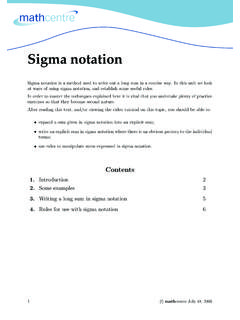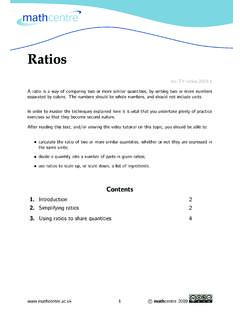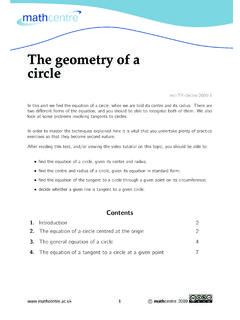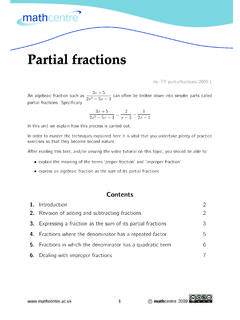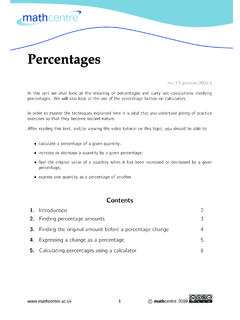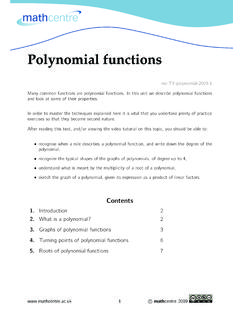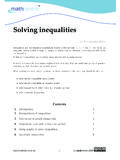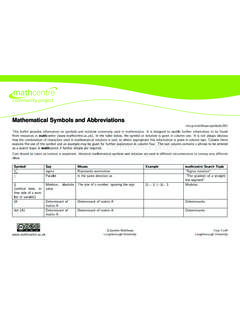Transcription of Linear equations in one variable - mathcentre.ac.uk
1 Linear equations in one variable mc-TY-simplelinear-2009-1. In this unit we give examples of simple Linear equations and show you how these can be solved. In any equation there is an unknown quantity, x say, that we are trying to find. In a Linear equation unknown quantity will appear only as a multiple of x, and not as a function of x such as x2 , this . x3 , x, sin x and so on. Linear equations occur so frequently in the solution of other problems that a thorough understanding of them is essential. In order to master the techniques explained here it is vital that you undertake plenty of practice exercises so that all this becomes second nature.
2 To help you to achieve this, the unit includes a substantial number of such exercises. After reading this text, and/or viewing the video tutorial on this topic, you should be able to: recognise simple Linear equations solve simple Linear equations check that your solutions are correct by substitution Contents 1. Introduction 2. 2. Solving equations by collecting terms 2. 3. Solving equations by removing brackets & collecting terms 3. 4. Linear equations with fractional coefficients 5. 5. Another form of Linear equation in one variable 8.
3 1 c mathcentre 2009. 1. Introduction In this unit we are going to be looking at simple equations in one variable , and the equations will be Linear - that means there'll be no x2 terms and no x3 's, just x's and numbers. For example, we will see how to solve the equation 3x + 15 = x + 25. 2. Solving equations by collecting terms Suppose we wish to solve the equation 3x + 15 = x + 25. The important thing to remember about any equation is that the equals sign represents a balance. What an equals sign says is that what's on the left-hand side is exactly the same as what's on the right-hand side.
4 So, if we do anything to one side of the equation we have to do it to the other side. If we don't, the balance is disturbed. Therefore, whatever operation we perform on either side of the equation, so long as it's done in exactly the same way on each side the balance will be preserved. Our first step in solving any equation is to attempt to gather all the x's together and to gather all the numbers together. From 3x + 15 = x + 25. we can subtract x from each side, because this will remove it entirely from the right, to give 2x + 15 = 25.
5 We can subtract 15 from each side to give 2x = 10. and finally, by dividing each side by 2 we obtain x=5. So the solution of the equation is x = 5. This solution should be checked by substitution into the original equation in order to check that both sides are the same. If we do this, the left is 3(5) + 15 = 30. The right is 5 + 25 = 30. So the left equals the right and we have checked that the solution is correct. Example Solve the equation 2x + 3 = 6 (2x 3). Solution From 2x + 3 = 6 (2x 3) we first remove the brackets on the right to give 2x + 3 = 6 2x + 3.
6 So that 2x + 3 = 9 2x 2 c mathcentre 2009. We are now in the same position as we were in during the first Example. We need to get the x's together by adding 2x to each side. 4x + 3 = 9. Now take 3 away from each side: 4x = 6. so that 6. x = ( by dividing both sides by 4). 4. 3. =. 2. 1. = 1. 2. When solving simple equations we should always check the solution by taking our answer and substituting it in the original equation to check that the left- and right- hand sides are the same. Substituting x = 1 21 in the left-hand side gives.
7 1. 2 1 +3= 3+3 =6. 2. Substituting x = 1 21 in the right-hand side gives: . 1. 6 2 1 3 =6 0=6. 2. So again, the left- and right- hand sides are equal - we've got that balance, so we know that we've got the right answer. Exercises 1. Solve the following equations . a) x + 5 = 9 b) 12 x = 7 c) 5x = 3. d) 4x + 10 = 2 e) 5 3x = 4 f) 2 + 14x = 30. g) 9 + 5x = 3x + 13 h) 4 3x = 8 + x i) 5 + 3(x 1) = 5x 6. 3. Solving equations by removing brackets & collecting terms Example Solve the equation 8(x 3) (6 2x) = 2(x + 2) 5(5 x). We begin by multiplying out the brackets, taking care, in particular, with any minus signs.
8 8x 24 6 + 2x = 2x + 4 25 + 5x 3 c mathcentre 2009. Each side can be tidied up by collecting the x terms and the numbers together. 10x 30 = 7x 21. Now take 7x from each side, and then add 30 to each side: 3x 30 = 21. 3x = 9. x = 3. And again you should take the solution (x = 3), substitute it back into the original equation to check that we have got the correct answer. On the left: 8(x 3) (6 2x) = 8(3 3) (6 2(3)) = 0 0 = 0. On the right: 2(x + 2) 5(5 x) = 2(3 + 2) 5(5 3) = 10 10 = 0. So both sides equal zero. The equation balances and so x = 3 is the solution.
9 Example Solve the equation (x + 1)(2x + 1) = (x + 3)(2x + 3) 14. We begin by removing the brackets. 2x2 + x + 2x + 1 = 2x2 + 3x + 6x + 9 14. So 2x2 + 3x + 1 = 2x2 + 9x 5. Remember we stated that we are dealing in this unit with Linear equations , so there should be no x2 terms. In fact, they all cancel out: There is a term 2x2 on both sides. We can subtract 2x2 from both sides to leave 3x + 1 = 9x 5. We can now proceed as in the earlier examples. 3x + 1 = 9x 5. 1 = 6x 5. 6 = 6x 1 = x So the solution is x = 1. As before, we can substitute it back into the original equation as a check.
10 On the left: (x + 1)(2x + 1) = (1 + 1)(2 + 1) = (2)(3) = 6. On the right (x + 3)(2x + 3) 14 = (1 + 3)(2 + 3) 14 = (4)(5) 14 = 20 14 = 6. So both sides equal 6 and the equations balance when x = 1. The solution is x = 1. 4 c mathcentre 2009. Exercises 2. Solve the following equations . a) 5(3 x) 2(4 3x) = 11 2(x 1) b) 6 4(x + 3) = 2(x 1). c) 5(1 2x) + 2(3 x) = 3(x + 4) + 14. 4. Linear equations with fractional coefficients Example Solve the equation 4(x + 2) 5x = 7+. 5 13. Solution In this Example the fractions are the cause of the difficulty.
